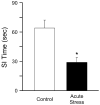Behavioural assays to model cognitive and affective dimensions of depression and anxiety in rats
- PMID: 18673411
- PMCID: PMC2603578
- DOI: 10.1111/j.1365-2826.2008.01772.x
Behavioural assays to model cognitive and affective dimensions of depression and anxiety in rats
Abstract
Animal models have been used extensively to investigate neuropsychiatric disorders, such as depression, and their treatment. However, the aetiology and pathophysiology of many such disorders are largely unknown, which makes validation of animal models particularly challenging. Furthermore, many diagnostic symptoms are difficult to define, operationalize and quantify, especially in experimental animals such as rats. Thus, rather than attempting to model complex human syndromes such as depression in their entirety, it can be more productive to define and model components of the illness that may account for clusters of co-varying symptoms, and that may share common underlying neurobiological mechanisms. In preclinical investigations of the neural regulatory mechanisms linking stress to depression and anxiety disorders, as well as the mechanisms by which chronic treatment with antidepressant drugs may exert their beneficial effects in these conditions, we have employed a number of behavioural tests in rats to model specific cognitive and anxiety-like components of depression and anxiety disorders. In the present study, we review the procedures for conducting four such behavioural assays: the attentional set-shifting test, the elevated-plus maze, the social interaction test and the shock-probe defensive burying test. The purpose is to serve as a guide to the utility and limitations of these tools, and as an aid in optimising their use and productivity.
Figures






Similar articles
-
Chronic unpredictable stress induces a cognitive deficit and anxiety-like behavior in rats that is prevented by chronic antidepressant drug treatment.Neuropsychopharmacology. 2008 Jan;33(2):320-31. doi: 10.1038/sj.npp.1301410. Epub 2007 Apr 4. Neuropsychopharmacology. 2008. PMID: 17406647
-
Enriched environment attenuates behavioral seizures and depression in chronic temporal lobe epilepsy.Epilepsia. 2017 Jul;58(7):1148-1158. doi: 10.1111/epi.13767. Epub 2017 May 8. Epilepsia. 2017. PMID: 28480502
-
Noradrenergic facilitation of shock-probe defensive burying in lateral septum of rats, and modulation by chronic treatment with desipramine.Prog Neuropsychopharmacol Biol Psychiatry. 2007 Mar 30;31(2):482-95. doi: 10.1016/j.pnpbp.2006.11.015. Epub 2006 Dec 26. Prog Neuropsychopharmacol Biol Psychiatry. 2007. PMID: 17188790
-
Ameliorating effects of aripiprazole on cognitive functions and depressive-like behavior in a genetic rat model of absence epilepsy and mild-depression comorbidity.Neuropharmacology. 2013 Jan;64:371-9. doi: 10.1016/j.neuropharm.2012.06.039. Epub 2012 Jul 2. Neuropharmacology. 2013. PMID: 22766393 Review.
-
The importance of cognitive phenotypes in experimental modeling of animal anxiety and depression.Neural Plast. 2007;2007:52087. doi: 10.1155/2007/52087. Neural Plast. 2007. PMID: 18288249 Free PMC article. Review.
Cited by
-
Behavioral and cognitive changes after early postnatal lesions of the rat mediodorsal thalamus.Behav Brain Res. 2015 Oct 1;292:219-32. doi: 10.1016/j.bbr.2015.06.017. Epub 2015 Jun 12. Behav Brain Res. 2015. PMID: 26079768 Free PMC article.
-
Effects of Single Cage Housing on Stress, Cognitive, and Seizure Parameters in the Rat and Mouse Pilocarpine Models of Epilepsy.eNeuro. 2019 Aug 1;6(4):ENEURO.0179-18.2019. doi: 10.1523/ENEURO.0179-18.2019. Print 2019 Jul/Aug. eNeuro. 2019. PMID: 31331937 Free PMC article.
-
Effect of estrous cycle on schizophrenia-like behaviors in MAM exposed rats.Behav Brain Res. 2019 Apr 19;362:258-265. doi: 10.1016/j.bbr.2019.01.031. Epub 2019 Jan 17. Behav Brain Res. 2019. PMID: 30660776 Free PMC article.
-
Behavioral Effects of Buspirone in Juvenile Zebrafish of Two Different Genetic Backgrounds.Toxics. 2022 Jan 7;10(1):22. doi: 10.3390/toxics10010022. Toxics. 2022. PMID: 35051064 Free PMC article.
-
Evaluation of Behavioral and Pharmacological Effects of Hydroalcoholic Extract of Valeriana prionophylla Standl. from Guatemala.Evid Based Complement Alternat Med. 2011;2011:312320. doi: 10.1155/2011/312320. Epub 2011 Jun 30. Evid Based Complement Alternat Med. 2011. PMID: 21754942 Free PMC article.
References
-
- Duyk G. Attrition and translation. Science. 2003;302:603–605. - PubMed
-
- Enserink M. Can the placebo be the cure? Science. 1999;284:238–240. - PubMed
-
- Matthews K, Christmas D, Swan J, Sorrell E. Animal models of depression: Navigating through the clinical fog. Neurosci Biobehav Revs. 2005;29:503–513. - PubMed
-
- McArthur R, Borsini F. Animal models of depression in drug discovery: A historical perspective. Pharm Biochem Behav. 2006;84:436–452. - PubMed
-
- Winsky L, Brady L. Perspective on the status of preclinical models for psychiatric disorders. Drug Discovery Today: Disease Models. 2005;2:279–283.

